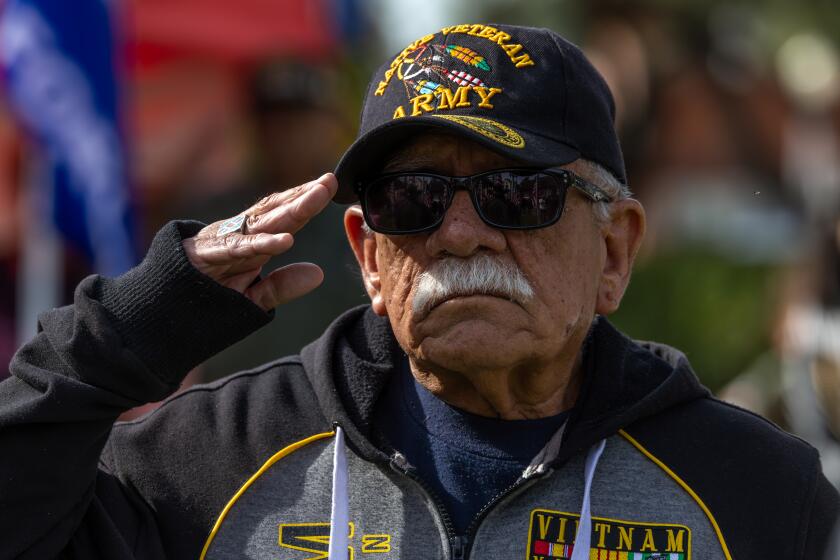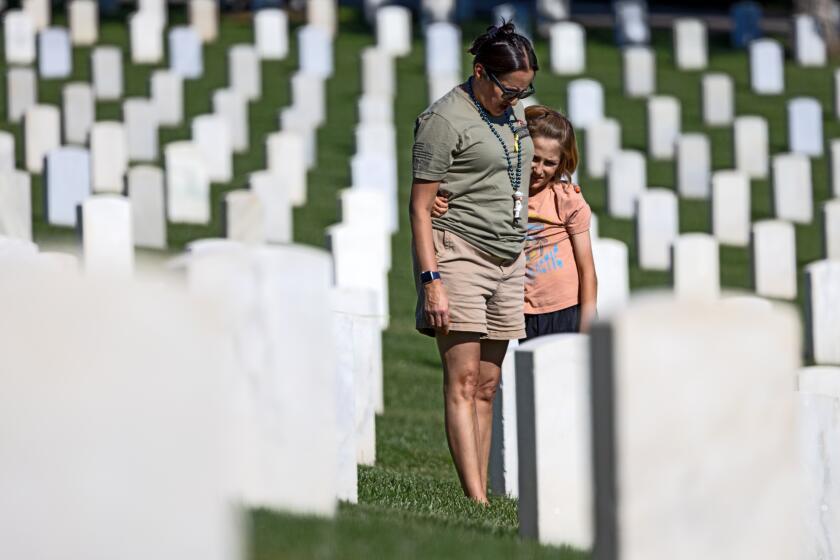‘For your honor’: Couple travel across Southland paying tribute to military veterans with memorial displays
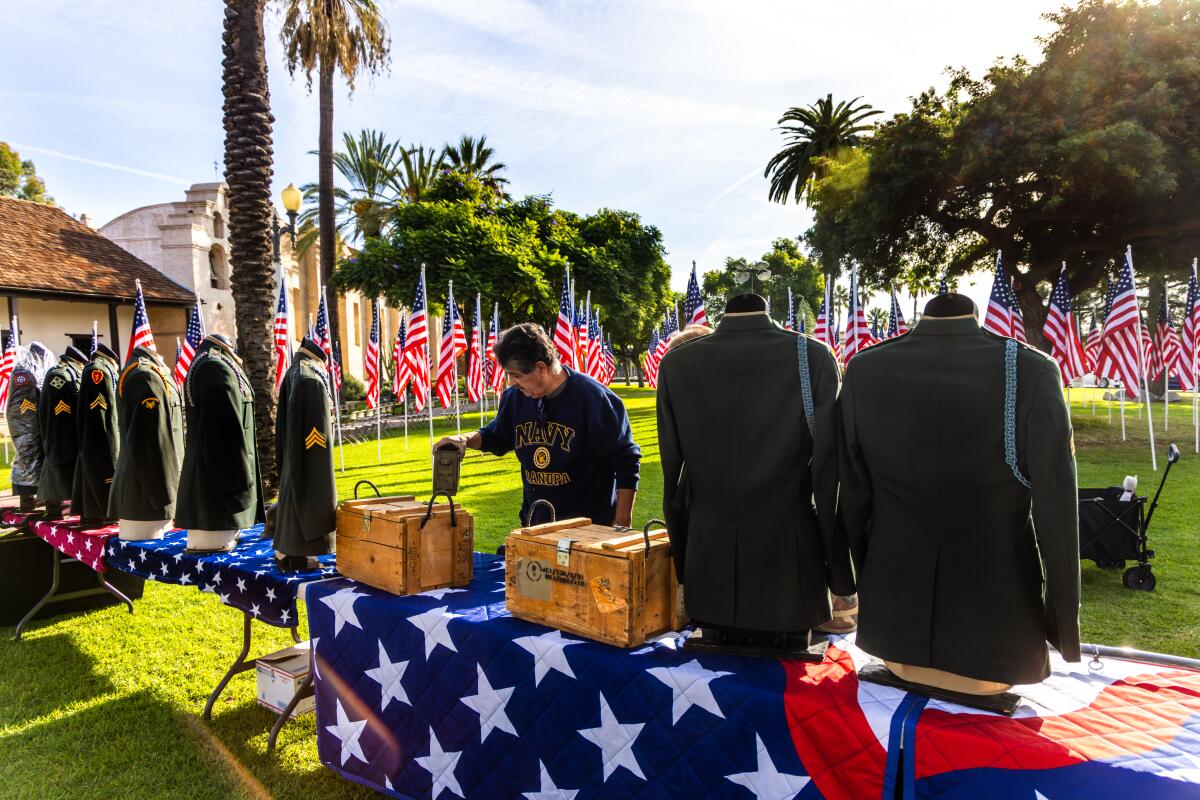
- Share via
Inside the small assembly hall of St. Isidore Historical Plaza in Los Alamitos, Linda Barringer gazed at the memorial display honoring U.S. service members.
A row of mannequins dressed in military uniform jackets stood on six folding tables draped in U.S. flag-inspired blankets. There were World War II relics such as medic bags, a field telephone and helmets. Large posters and photographs showed military heroes such as Cpl. Ira Hayes, who helped raise the American flag on Iwo Jima.
“It’s inspiring,” said Barringer, 70. “It makes you realize what people went through for our freedom and the sacrifices that they’ve made.”
It was the first time Barringer had seen the display, one of many set up by a Southern California couple to pay tribute to veterans of the armed forces and those who have died.
For years, Art and Jill Hernandez have traveled around the region, setting up military memorials at schools, colleges, funerals and major events such as the Fourth of July and Veterans Day.
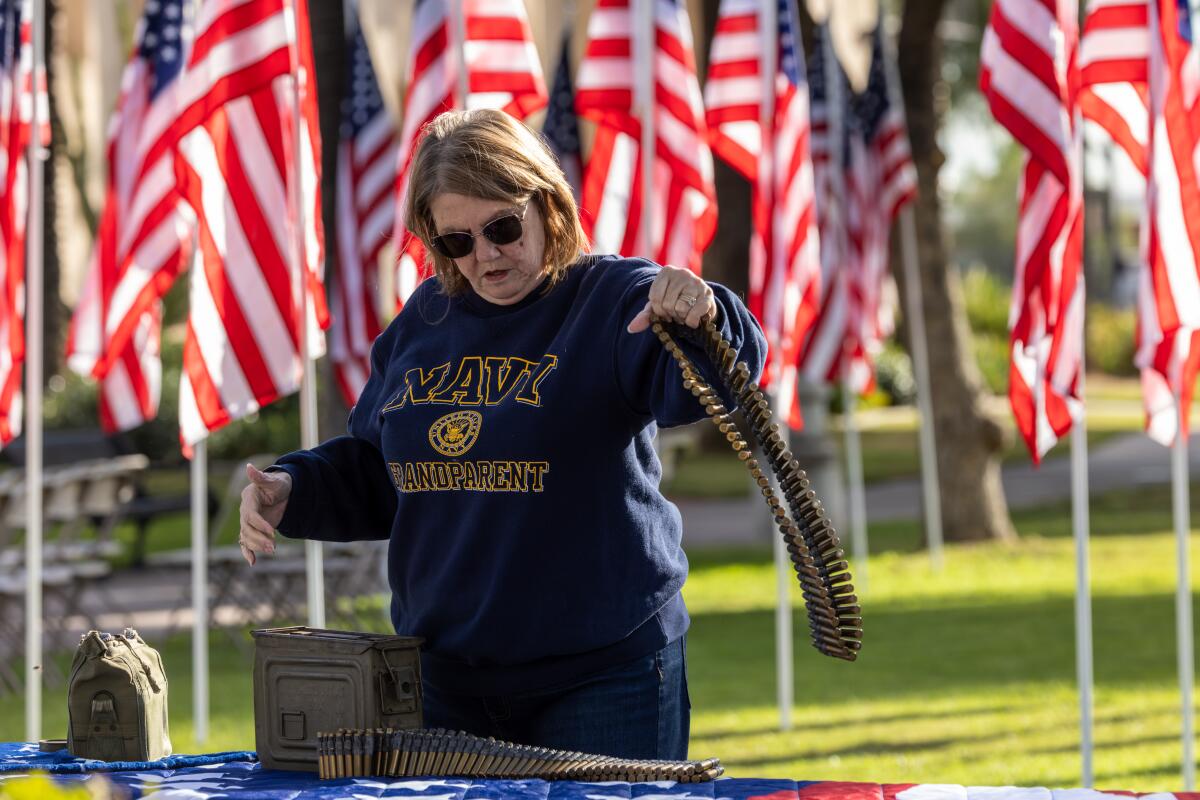
They don’t take any payment for their work, and they’re in such high demand that they’ve recently had to turn down some requests. Next year, they are scheduled to travel to San Antonio at the request of the U.S. Army’s 1st Cavalry Division. It will be the farthest the couple have gone to set up their memorial display, which they call “For your honor.”
“We love doing it,” said Jill Hernandez, 67. “I have about five to six relatives who served in the military.”
Her husband, 74, said he has about 13 veterans in his family and does it to honor them.
The idea for the display took root about 10 years ago. Art Hernandez, then a maintenance worker at San Gabriel High School, was walking past a history class when a teacher called him over. The students were learning about the Pacific War, and the teacher had been asking the students to identify a country on a map. She didn’t think many people knew, including Hernandez.
But Hernandez knew it was the Philippines because his father, Air Force Sgt. Andrew Rojas Hernandez, had served in the 421st Night Fighter Squadron during World War II. He had conducted many night missions in the Philippines as a radar operator on a P-61 Black Widow, a twin-engine fighter plane.
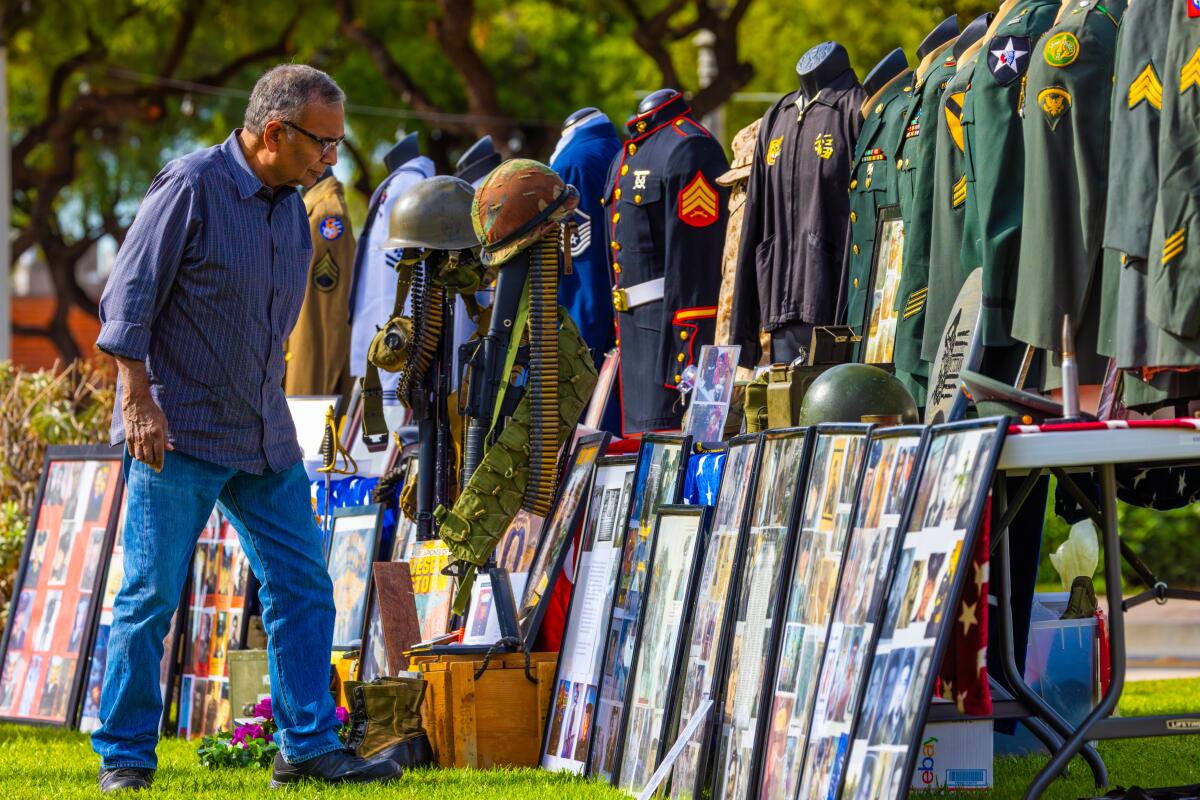
And so he told the class this story. He also offered to bring in World War II memorabilia he had collected over the years. The instructor not only agreed but told teachers in other schools about it.
“That was the start of it,” Hernandez said. “That’s also how I got the idea for the uniform jackets on mannequins.”
The couple soon found themselves being requested by middle schools, high schools and colleges. As word spread, they started doing parties and holidays. Three years ago, they started setting up personalized funeral displays for veterans; they have done about a dozen since.
Some of the uniforms on display were purchased by the couple; others were donated by veterans or family members of veterans who wanted to preserve the story of their relative’s time in service.
“The uniforms come with stories,” Hernandez said. “Sometimes I’ll display the uniform the way it was given to me.”
Photographs of some of the donors sit next to the uniforms they gave. Hernandez said he often shares a bit of their stories to people who are curious about them.
While U.S. flags come out on Memorial Day, poppies are more identified with Veterans Day.
The memorial display is very much like a mini-museum. It includes large posters with text and photographs of important military figures and stories such as that of Mexico’s 201st Air Fighter Squadron, known as the Aztec Eagles, which was attached to the U.S. Air Force and sent to the Philippines in March 1945.
Some stories are more personal, such as that of Joanne Ramirez, whose father and two uncles were wounded in different World War II battles and recovered at the same hospital without realizing it.
Jill Hernandez said the memorials can vary in size and time needed to set up. On Sunday, the setup in Los Alamitos had taken two and a half hours to complete, but a display of just a uniform and a few items can take less than 30 minutes. Over the previous four days, the couple had traveled to events in San Gabriel, Glendora and Hesperia, spending about as much time in the car as it would have taken to drive from Los Angeles to San Francisco.
Inside the assembly hall on Sunday, standing with hands behind her back, Anita Rios, 69, stared at a large framed photograph of an Army soldier. The photo stood between M1 and M16 rifles with two green helmets resting on top of them, a symbol of a fallen soldier in battle.
“I love looking at the different uniforms and the family stories,” Rios said.
For a moment, she began to think of her father.
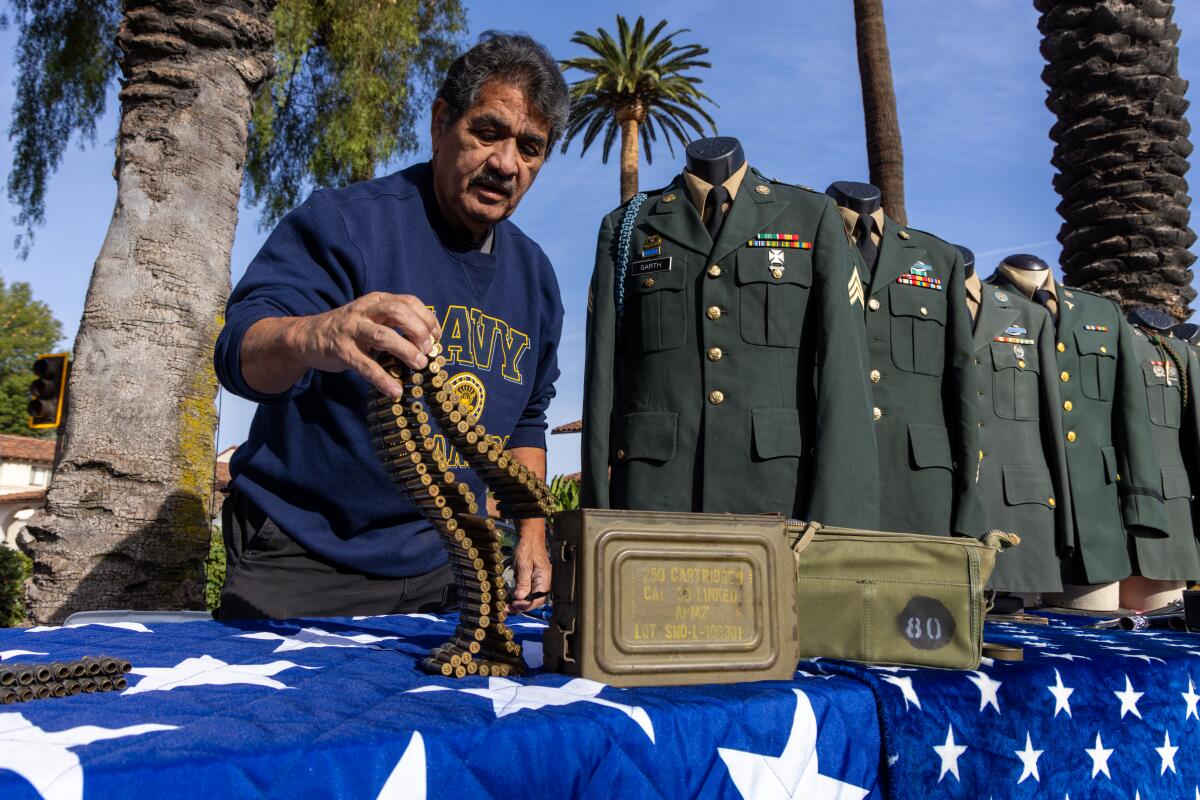
“He was a tail gunner on a bomber in England, and his flight suit — you know they’re heated, and the heating went out on his right hand and his fingers froze to the gun and he wound up having his fingers amputated,” she said. “That got him a discharge.”
She said her father learned to write with his left hand, and the amputation of his fingers never stopped him from working. But in all the years she knew him, he never spoke about his time in the service.
“I never pushed him on it,” she said.
Not far away, Barringer, who was seeing the display for the first time, thought about donating items her father had left behind: newspaper clippings and Life magazines from the 1940s.
People reverentially observe Veterans Day at Los Angeles National Cemetery in Westwood. Veterans Day events were held at Forest Lawn—Hollywood Hills and the Bob Hope Patriotic Hall
Jill Hernandez said the memorial generates varying emotions from those who come to see it.
“Some people will keep walking by, some people will stand and cry, some people will talk to [my husband] for two hours,” she said.
Among those venturing into the assembly hall was California Sen. Janet Nguyen (R-Santa Ana), whose family came to the U.S. as refugees from Vietnam when she was 5. Hernandez walked alongside her, telling her stories about the uniforms and photographs he had on display.
“It was very emotional just looking at it and being able to see the stories behind each of the exhibits,” she said. “For our children today, just Googling it is very different than actually seeing it; it’s so powerful to see it and be able to touch [the items].”
It was nearing 5 p.m. when Jill and Art Hernandez began to break down the display, wrapping plastic bags around the mannequins and putting smaller items into bins. With the help of a friend who had tagged along for the day, they hauled everything back to their minivan for the hourlong drive back home to Ontario.
More to Read
Sign up for Essential California
The most important California stories and recommendations in your inbox every morning.
You may occasionally receive promotional content from the Los Angeles Times.
